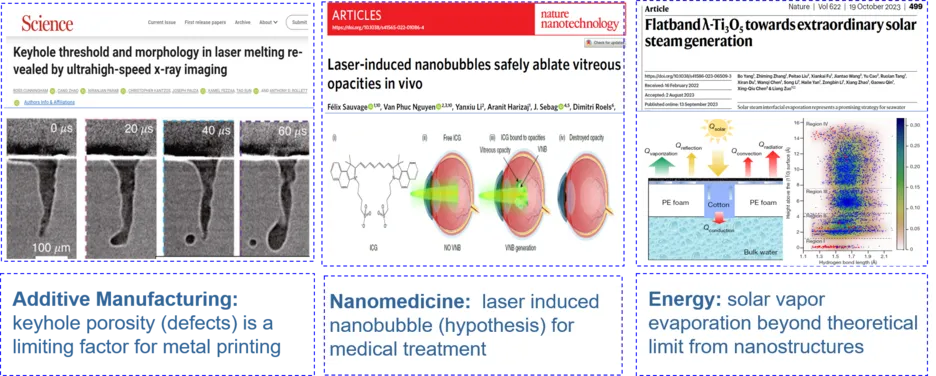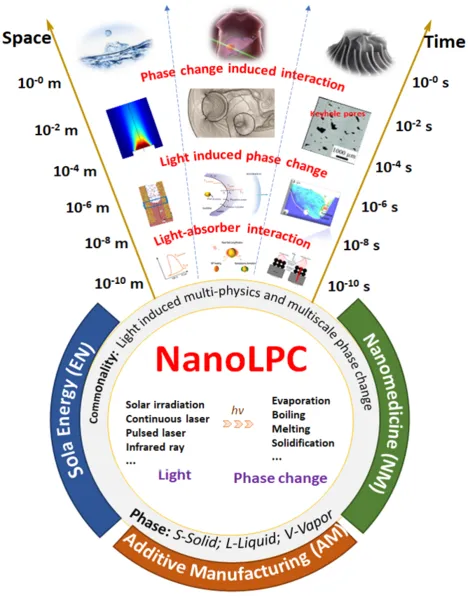NanoLPC: Engineering Light-induced Phase Change for emerging Nanoscale processes
1.Phase change and industrial relevance
Phase change such as vaporization, condensation, melting and solidification is a first-order phase transition involving latent heat, which is an old topic but has become increasingly important for many emerging applications. In additive manufacturing for metals, melting and solidification are the basics of the printing process, but laser induced vaporisation and the formation of keyhole pores, i.e., porosity defects, are currently a major limiting factor for metal printing. In nanomedicine area, various nanoparticles are used for controlled drug delivery and therapies, and laser excited nanobubble inducing shockwave is a powerful tool for ablating vitreous opacities in vivo. In solar energy utilization, direct steam generation/vapor production from bulk or surface fluid surface is a promising technology for enhancing solar energy efficiency in the post-fossil fuel era and improving clean water production.
2. Light induced phase change
The fundamental physics governing these apparently different processes is the light-induced phase change (LPC) due to the strong non-linear interaction of light and absorbing materials, leading to different phase change phenomena across different scales. These apparently different processes follow some common consequent paths, i.e., light-absorber interaction (LAI) leads to temperature rise of the absorber, which induces localized phase change, and phase change interaction with the surrounding renders different effects, either preferred or unwanted.
Phase change has been a long research topic in the domain of thermodynamics and heat transfer. Considering the fundamental process of phase change, which ranges from nucleation to strong interfacial heat and mass flow coupling, it is still presenting as a forefront research area with many challenges ahead because of the multiscale nature. LPC adds further complexities by introducing the multiphysics nature due to the strong LAIs. Due to such multiscale multi-physics nature, understanding and manufacturing LPC for designed processes is extremely challenging, which ranges from strong non-linear LAIs, size-dependent properties prediction, mis-linkage between what occurs at the nanoscale and bulk scale, and transient NB dynamics associated with shockwave penetration, as well as the difficulties of performing nanoscale experiments to obtain reliable measurement especially under strong influence of phase change. For currently engineering applications, only some empirical correlations / simplified equations are used to describe LPC in different sectors. There is a strong need to advance our understanding of LPC process, and develop reliable physics-informed tools to predict and reverse engineering the LPC process for emerging applications
3. Aim and objective
In this project, we define LPC as the unifying theme for different apparently non-related emerging applications, and will conduct a systematic study of light induced phase change phenomenon, from multiscale and multiphysics aspects. In particular, we will
- Unify the LPC study from three fundamental processes, i.e., light absorber interaction, light induced phase change and phase changed induced interactions;
- Establish a unique physics-informed multiscale simulation platform, validated by multiscale phase change experiments, to advance the fundamental understanding of LPC;
- Develop LPC applications in different emerging industries from additive manufacturing, nanomedicine to solar energy, and beyond.
4. Major work
We will develop systematic approaches to provide fundamental understanding of NanoLPC from multiscale experimentation and simulation aspects, not only to enhance the understanding of LPC throughout different scales, but also support a range of emerging applications:
- Establish a light induced multiphysics and multiscale phase change simulation platform, which allow us to capture LAI, and couple molecular information into macroscopic phase change simulation.
- Establish a multiscale LPC experimental system, which allows to probe light induced phase change mechanism and provide valuable validation data for multiscale modelling above.
- Develop NanoLPC application in solar energy, by exploring fundamentally the controversy regarding the abnormal evaporation rate, and simulate/ predict vapor production rate to guide design of optimized interfacial evaporator
- Develop NanoLPC application in nanomedicine, by establishing a unique multimodel experimental system together with functionalized nanomaterials to examine the nanobubble phenomenon, supported by multilscale numerical studies.
- Develop NanoLPC fapplication in additive manufacturing, by developing multiscale simulation tool for keyhole dynamics and pore formation prediction suitable for PBF applications
5. Expected outcome
By tacking the fundamental challenge of the formation and control of LPC and developing a physics-informed platform, it will not only advance LPC understanding in the domain of Thermodynamics and Heat Transfer, but also transfer the developed expertise into emerging applications. Many breakthroughs beyond state-of-art work are expected, such as i) the establishment of a unique multi-physics and multiscale LPC simulation platform; ii) the revelation of LPC mechanisms by multiscale experiments with localized temperature and nanobubble dynamics measurement; and iii) the reverse engineering of LPC to maximize solar vapor production, inhibit keyhole pore formation and control nanobubble shockwave effects.
6. Talent calling
The project also opens a number of job opportunities for ambitious researchers (both postdoc working and PhD studies) to join us and work at the forefront of this exciting project, from November 2024
We are looking for outstanding /ambitious candidates with strong expertise / background in
- Multiscale coupling and simulation,
- Nanoscale heat transfer experimentation,
- Light mater interactions,
- Nucleation and phase change physics,
- Functional nanomaterials and interface,
- Heat related nanomedicine,
- Metal printing and additive manufacturing,
- Solar interfacial reactor
For interested candidate, please feel free to contact Prof. Wen (d.wen(at)tum.de) for further details.

